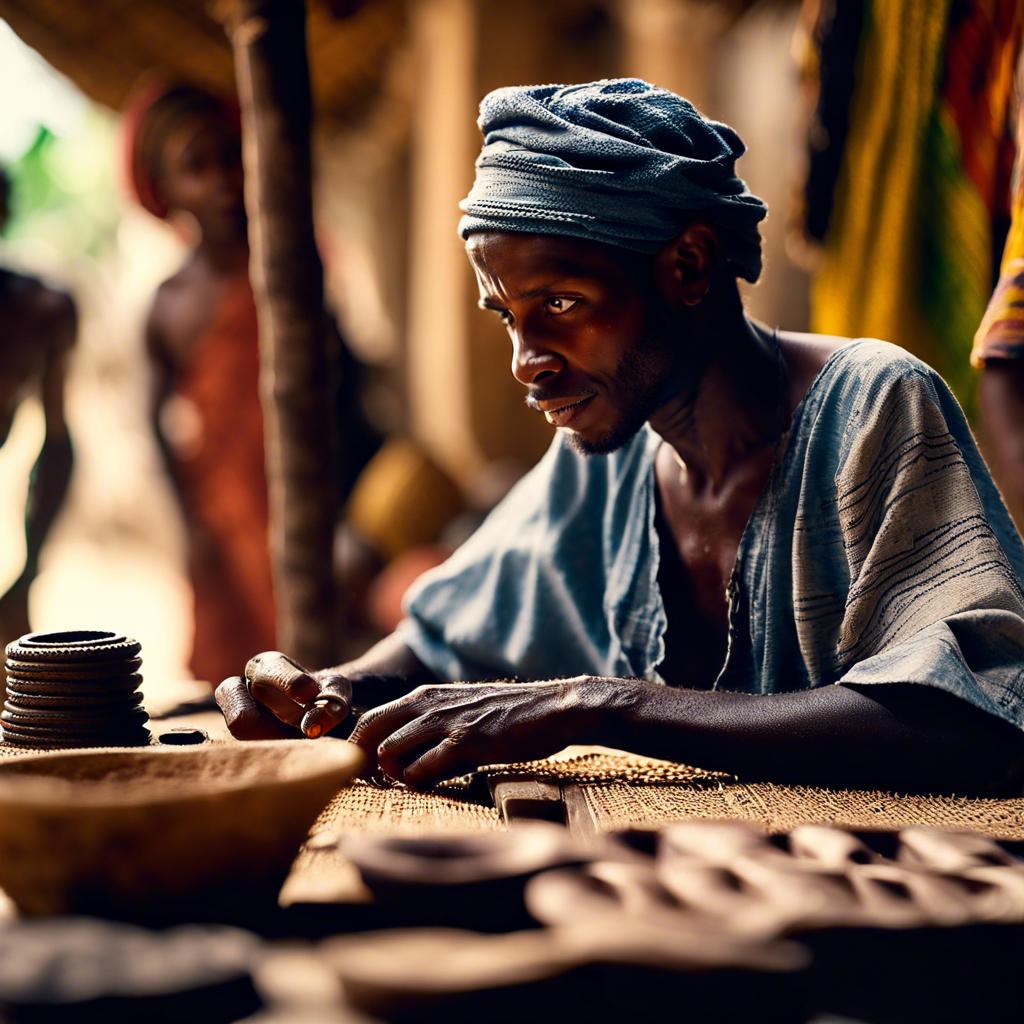Welcome to a captivating exploration of Zanzibar’s vibrant art and crafts scene, brought to you by Tours-Zanzibar.com. Nestled off the coast of mainland Tanzania, Zanzibar is famous for its picturesque beaches and rich historical tapestry. Still, it is also a bustling hub for unique and diverse artistic expressions. This article takes you on a journey through the local creativity that permeates the islands, showcasing how traditional techniques have transcended generations and are being preserved and reinvented in contemporary formats. From intricately carved wooden doors in Stone Town to the delicate art of kanga making, join us as we delve into the cultural heritage and artistic innovations that make Zanzibar a true treasure trove for connoisseurs of art and craftsmanship.

Exploring Zanzibar’s Rich Artistic Heritage
The Tapestry of Local Talent
The island of Zanzibar is not just a picturesque locale with stunning beaches and a vibrant cultural mosaic; it also boasts a remarkable artistic community whose works are steeped in tradition and innovative expressions. From the delicate dance of brush strokes on canvas to the intricate carvings in wood and stone, each piece tells a story of the archipelago’s rich history and heritage.
Traditional Crafts
Artisans in Zanzibar employ age-old techniques handed down through generations. Wood carving is particularly prominent, with mahogany and ebony being the most commonly used materials. These carvings often depict figures and scenes from daily life, mythological stories, or the region’s abundant wildlife.
- Mkeka: Woven mats made from palm leaves are typically used during meals.
- Kanga: Colorful garments worn by women also serve as a form of communication through Swahili sayings imprinted on them.
- Udi: A traditional perfume made by distilling flowers and spices, reflecting the island’s historical involvement in the spice trade.
Contemporary Art Scene
The contemporary art scene in Zanzibar is dynamic and evolving, characterized by a blend of local and international influences. Newer artists are reimagining traditional motifs and crafts, infusing them with modern themes and techniques. Paintings, sculptures, and installations often explore socio-economic issues, identity, and globalization’s impacts on local cultures.
| Gallery/Artist | Type of Art | Notable Works |
|---|---|---|
| Sauti za Busara | Mixed Media | “Voices of Wisdom” Installation |
| Zanzibar Gallery | Paintings & Sculptures | “Mwaka Kogwa” Series |
| The Stone Town Artisan Quarter | Textiles & Carvings | Contemporary Kanga Designs |
Such a diverse palette of artistic expressions provides a deep insight into Zanzibar’s heart and soul, connecting visitors with the island’s past and present through the universal language of art.

The Influence of Swahili Culture on Zanzibar’s Crafts
Swahili Artistic Expression in Zanzibar
The rich Swahili culture, with its deep historical and trade ties spanning from the African mainland to the Arabian Peninsula, has left an indelible mark on Zanzibar’s artistic landscape. Tourists and art lovers find the island’s crafts unique in their blend of indigenous techniques and borrowed motifs. This cultural merger produces visually striking artifacts and items steeped in symbolic meaning.
Key Craft Forms
Among the standout crafts, several forms are particularly illustrative of Swahili influence:
- Wood Carving: Skilled artisans create intricate designs on doors, furniture, and the famous Zanzibar chests. These items often feature geometric patterns and calligraphic inscriptions dating back to when the island was a sultanate.
- Kanga: These are colorful fabrics women wear and are esteemed for their expressive Swahili proverbs. The tradition of weaving and dyeing these textiles has been passed down through generations, combining local customs with techniques from the Far East.
- Ukili Baskets: Made from palm leaves, these baskets showcase the weavers’ precision and creativity. They reflect a functional art form that has been part of the Swahili household essentials for centuries.
Each craft piece tells a story, embedding within it narratives of trade, tradition, and the continually evolving culture of the Swahili people. Tours-Zanzibar.com offers customized art tours that give visitors an in-depth understanding of Zanzibar’s artistic heritage, with detailed insights into the craft techniques and the cultural history that inspires them.
Influence of Trade and Interaction
| Craft | Origins Influenced By |
|---|---|
| Zanzibar Chests | Arabic and Indian Craftsmanship |
| Kanga Fabric | Regional African Textiles, Indo-Pakistani Designs |
Fostering an appreciation for Zanzibar’s crafts involves acknowledging the Swahili ethos of adaptation and synthesis, narrated beautifully through their traditional and contemporary crafts. By studying and celebrating these crafts, one better understands Zanzibar’s cultural tapestry.
Mastering Traditional Techniques: A Close Look at Ufundi
Delving into the Heart of Ufundi
The rich tapestry of Zanzibar’s art forms is nowhere more vibrant than in the traditional craft known as Ufundi. This age-old practice encapsulates a range of skills, from weaving and carving to the intricate art of basketry. The local artisans, often hailed as the custodians of cultural heritage, work with locally sourced materials, adding to the authenticity and environmental consciousness of their creations.
Materials and Methods
Exploring Ufundi begins with understanding the materials utilized. Local woods, fibers , and dyes all play a pivotal role in creating these crafts. Artisans select materials based on availability, functionality, and symbolism. For instance:
- Coconut fibers and leaves: Used predominantly in making baskets and mats.
- Mkonga wood is preferred for its durability and smooth texture, making it ideal for carving detailed items such as masks and door frames.
- Natural dyes: Derived from plants and minerals, these are used to color fabrics and threads for weaving.
Techniques Preserved Through Generations
The techniques used in Ufundi are not just about crafting objects but also means of storytelling and preserving history. In the intricate weaving patterns of a Zanzibar mat, one can read stories of migration, trade, and the island’s diverse influences. Carving, another predominant technique, showcases aesthetic appeal and serves as a narrative device, often depicting scenes from local folklore and daily life.
By nurturing these techniques, Zanzibar preserves its past and ensures that its artistic expressions have a future. Join us at Tours-Zanzibar. Look at these mesmerizing traditions guided by those who know them best—the local artisans.
Spotlight on Zanzibar Carvings: From Doors to Decor
The Enchantment of Woodwork
In the heart of Zanzibar, the art of wood carving stands as a profound expression of cultural heritage, prominently showcased in the intricate designs of Zanzibar doors. These masterpieces are not merely entryways but narrate stories, traditions, and the artistic pursuits of local artisans that date back centuries. The carvings are typically adorned with motifs that symbolize protective charms and a welcoming aura to any home.
Variety and Techniques
While exploring this island’s rich tapestry of arts, you will encounter various styles, each reflecting the unique influences that have touched Zanzibar over the years. Most renowned is the Bhuj carving, with its Indian influences and intricate patterns, and the Makunduchi style, which reflects more traditional, straightforward cuts heavily influenced by African aesthetics.
Expanding Beyond the Traditional
The traditional skills of Zanzibar carvers have transcended the ages, evolving into a dynamic range of ornamental and functional items. Today, artisans extend their craftsmanship to:
- Furniture making — Elaborate bed frames and coffee tables, echoing the classic door designs.
- Decorative panels — Utilized in interior décor, enhancing the ambiance with a touch of Zanzibar’s essence.
- Souvenir creations — Smaller, portable carvings are making perfect mementos for visitors.
This adaptability not only preserves the ancient techniques but also ensures the sustenance of Zanzibar’s artistic heritage in modern times. To experience these wonders firsthand or to learn more about local arts and crafts, Tours-Zanzibar.com offers specialized tours that delve into the island’s rich craftsmanship.
Zanzibar’s Thriving Contemporary Art Scene
Exploring Vibrant Expressions
An artistic revolution burgeons in the heart of Zanzibar, fueled by established and emerging talents. The island’s unique blend of African, Arab, Indian, and European influences brews a visual and tactile feast for art lovers. One can’t help but be captivated by the kinetic energy of local art studios and galleries that dot Stone Town and its environs – each offering a window into the soul of Zanzibari culture through innovative contemporary pieces.
Highlights of the Artistic Landscape
Spaces like the Zanzibar Gallery and the Art House are among the vanguard of this cultural resurgence. These venues showcase paintings and sculptures and serve as platforms for critical dialogue and community engagement. A visit here offers insight into the motifs of Swahili architecture and the natural environment that so heavily influences local artists. Moreover, regular exhibitions, workshops, and talks allow visitors to connect deeply with the island’s artistic pulse.
Must-Experience Local Crafts
- Carving Craftsmanship: Wood carvings in Zanzibar are intricate and often carry deep symbolic meanings related to local myths and traditions. Workshops allow visitors to see artisans at work, chiseling fine details into ebony and mahogany.
- Tingatinga Paintings: This distinctively East African painting style is vibrant and colorful, characterized by its whimsical portrayal of animals and everyday life. It expresses the region’s diverse flora and fauna.
- Dhow Artistry: Traditional dhow boats, treasured for their historical and cultural significance, inspire unique art forms, from miniature models to creative furniture pieces using recovered dhow wood.
Every piece you discover in Zanzibar tells a story of the archipelago’s rich heritage and its contemporary renaissance. Walking through the winding lanes, where art virtually spills out of open windows and doorways, it’s clear that the island is a living canvas, continually painted by the hands of its vibrant community.
| Activity | Details | Location & Time |
|---|---|---|
| Gallery Tour | Guided tour through key contemporary galleries | Varies; generally 2-3 hours |
| Workshop Participation | Hands-on arts and crafts sessions with local masters | Art House, Stone Town; Half-day sessions |
| Artisan Market Visits | Explore local artisan markets with an expert guide | Weekly in various locations |
With every turn and every piece viewed, the depths of Zanzibar’s art scene become more apparent, making a journey with Tours-Zanzibar.com not just a trip but a profound exploration of artistic spirit.
Where to Buy Authentic Zanzibar Art and Crafts
Exploring Local Markets and Shops
For those looking to immerse themselves in the rich tapestry of local culture, the markets of Stone Town are an excellent place to start. Here, artisans from across the island come to sell their unique creations, making it a vibrant hub for acquiring authentic Zanzibari art and crafts. One must-visit shop is Mkunazini Street Market, known for its wide array of handmade goods, from intricate beadwork to traditional Swahili carvings.
Top Picks for Authentic Crafts
- Hurumzi Street – Known for its finely woven textiles and colorful kangas (traditional wear).
- Gizenga Street – Offers a plethora of spices alongside beautifully crafted wooden spice chests, perfect as practical mementos.
- Fahari Zanzibar – A social enterprise shop that provides high-quality crafts and supports local artisans in maintaining their livelihoods.
Each location boasts a friendly atmosphere, where haggling is both expected and part of the fun. Engaging with the sellers gets you a better deal and a story behind the art piece you are bringing home – adding an invaluable layer of personal connection to your purchase.
Venues for Unique Artistic Pieces
| Gallery | Specialty | Location |
|---|---|---|
| Driftwood Art Studio | Reclaimed wood sculptures | Shangani Street, Stone Town |
| Ngome Kongwe Art Shop | Historical and cultural paintings | Near the Old Fort |
| Maruhubi Gallery | Contemporary and abstract art pieces | Maruhubi Area |
Visiting these cultural pavilions provides an opportunity to buy unique artworks and see artists in action, possibly discussing methods and inspirations. This deepens one’s appreciation of the crafts purchased, turning simple shopping into a memorable cultural encounter.
Tips for Supporting Local Artists and Craftsmen
Embrace the Unique Offerings of Zanzibar’s Creative Minds
Exploring the rich tapestry of Zanzibar’s art scene is about admiring beautiful works and actively participating in the sustainable growth of the local creative economy. When you choose to purchase handmade crafts, you’re directly contributing to the livelihood of the artists and promoting the preservation of their cultural heritage. Here are practical ways you can support these talented individuals:
- Visit local galleries and workshops: Take the time to visit places where artists display their work. This helps you better understand the context of the art and allows you to meet the creators, offering more personal interaction and insight.
- Attend art fairs and exhibitions: These events are crucial for local artists to gain visibility and sell their creations. Your presence boosts their confidence and market presence.
Purchase Responsibly and Spread the Word
Purchasing a piece of art or craft from Zanzibar is more than just a transaction. It’s an investment in the community. To ensure that this impact is positive, consider the following:
- Seek authenticity: Always look for authentic pieces representing Zanzibar’s artistic traditions. Avoid mass-produced souvenirs that often exploit cultural designs without benefiting the local economy.
- Recommendations matter: If you admire a particular artist or craftsman’s work, recommend them to friends or family. Online reviews and social media shares can significantly increase their exposure.
Lastly, remember that your support helps to foster a vibrant future for Zanzibar’s arts and crafts community, enabling them to thrive and continue their cultural expressions. By following these tips offered by Tours-Zanzibar.com, you actively cultivate an ecosystem where art is appreciated and celebrated, ensuring that these artistic traditions are passed on to future generations.
Celebrating Zanzibar’s Artistic Future Through Community Initiatives
Fostering Local Talent
Zanzibar is known for its pristine beaches, exotic spices, and vibrant art scene, which tells the story of a rich cultural tapestry through each brush stroke and chisel mark. At Tours-Zanzibar.com, we’re passionate about nurturing the next generation of local artists. Introducing community initiatives has enabled us to support young talents, providing them with the platforms and resources necessary to grow and thrive.
These initiatives range from art workshops and exhibitions to mentorship programs pairing burgeoning artists with seasoned professionals. The emphasis is on creating a sustainable artistic ecosystem that encourages creative expression and cultural preservation.
Art Initiatives and Programs
The heart of our efforts lies in several critical programs designed to create opportunities and enhance skills:
- Local Art Workshops: These workshops, which are aimed at youths and adults alike, are led by local artisans skilled in everything from painting and sculpture to beadwork and pottery.
- Annual Art Fairs: These fairs offer artists a venue to showcase and sell their work, boost the local economy, and help artists gain visibility.
- Cultural Exchange Programs: These programs connect Zanzibar artists with peers worldwide, fostering a global dialogue and exchange of artistic ideas.
Impact on the Community
The benefits of these community-driven art initiatives are palpable. They not only add to the island’s aesthetic appeal but also play a crucial role in the area’s socio-economic development. Artists who once struggled to gain recognition now find themselves at the forefront of the local art scene, invigorating Zanzibar’s cultural landscape and attracting international attention.
For travelers eager to explore Zanzibar’s artistic offerings, Tours-Zanzibar.com ensures a deep, enriching experience that delves into the heart and soul of the island’s creative community.
Future Outlook
As we conclude our exploration of Zanzibar’s vibrant arts and crafts scene, it becomes evident that the island is not just a place of stunning natural beauty but also a vibrant hub of creativity. From weaving intricate kikoi and kangas to the meticulous craftsmanship of Zanzibar doors and the lively Tingatinga paintings, each art form offers a unique window into the cultural tapestry of this enchanting archipelago. These artistic expressions are not merely products of individual creativity but are deeply embedded in the region’s historical, social, and cultural narratives.
For travelers and art enthusiasts alike, Zanzibar represents a rich cultural journey—a chance to immerse oneself in traditions shaped by a blend of African, Arab, Indian, and European influences. Engaging with Zanzibar’s art and crafts is more than an aesthetic experience; it is a form of cultural dialogue and an opportunity to support the local economy through ethical tourism and appreciation of artisan crafts.
Whether you are drawn to the delicate beauty of Zanzibar’s jewelry, its textiles’ bold patterns, or its woodwork’s historical resonance, each artifact tells a story worth preserving. We invite readers to delve deeper, visit galleries, participate in workshops, and bring home pieces that serve as souvenirs and help sustain the traditional skills of Zanzibari artisans.
Reflecting on the art and crafts of Zanzibar reminds us of the power of art to cross boundaries, connect us to the past, and inspire future generations. It is a testament to the island’s enduring spirit of creativity that continues to captivate and enchant visitors from across the globe.














